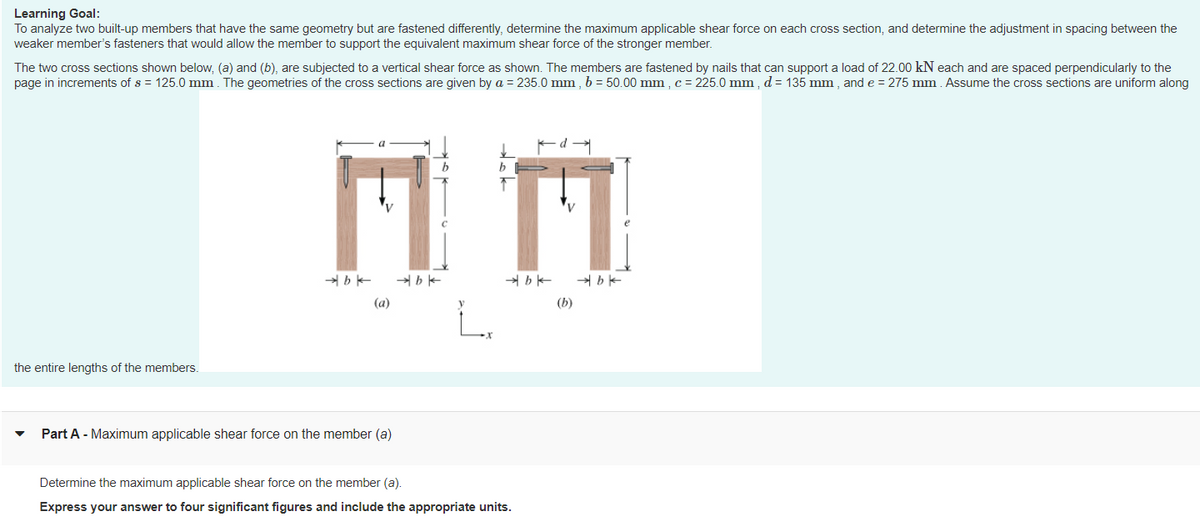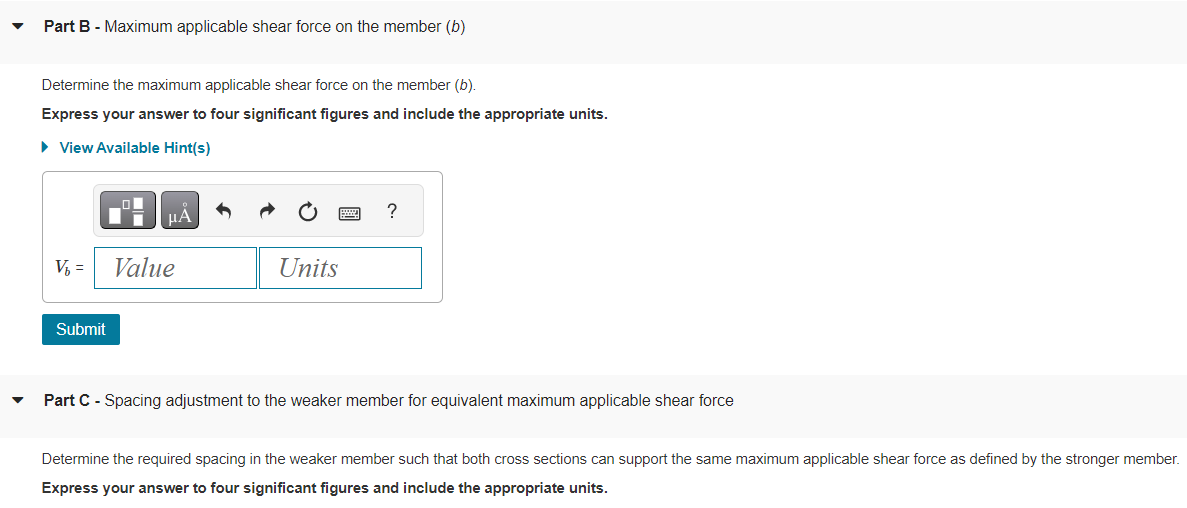To analyze two built-up members that have the same geometry but are fastened differently, determine the maximum applicable shear force on each cross section, and determine the adjustment in spacing between the weaker member's fasteners that would allow the member to support the equivalent maximum shear force of the stronger member. The two cross sections shown below, (a) and (b), are subjected to a vertical shear force as shown. The members are fastened by nails that can support a load of 22.00 kN each and are spaced perpendicularly to the page in increments of s = 125.0 mm. The geometries of the cross sections are given by a = 235.0 mm, b = 50.00 mm, c = 225.0 mm, d = 135 mm, and e = 275 mm. Assume the cross sections are uniform along a Kd-
To analyze two built-up members that have the same geometry but are fastened differently, determine the maximum applicable shear force on each cross section, and determine the adjustment in spacing between the weaker member's fasteners that would allow the member to support the equivalent maximum shear force of the stronger member. The two cross sections shown below, (a) and (b), are subjected to a vertical shear force as shown. The members are fastened by nails that can support a load of 22.00 kN each and are spaced perpendicularly to the page in increments of s = 125.0 mm. The geometries of the cross sections are given by a = 235.0 mm, b = 50.00 mm, c = 225.0 mm, d = 135 mm, and e = 275 mm. Assume the cross sections are uniform along a Kd-
Elements Of Electromagnetics
7th Edition
ISBN:9780190698614
Author:Sadiku, Matthew N. O.
Publisher:Sadiku, Matthew N. O.
ChapterMA: Math Assessment
Section: Chapter Questions
Problem 1.1MA
Related questions
Question

Transcribed Image Text:Learning Goal:
To analyze two built-up members that have the same geometry but are fastened differently, determine the maximum applicable shear force on each cross section, and determine the adjustment in spacing between the
weaker member's fasteners that would allow the member to support the equivalent maximum shear force of the stronger member.
The two cross sections shown below, (a) and (b), are subjected to a vertical shear force as shown. The members are fastened by nails that can support a load of 22.00 kN each and are spaced perpendicularly to the
page in increments of s = 125.0 mm. The geometries of the cross sections are given by a = 235.0 mm, b = 50.00 mm, c = 225.0 mm, d = 135 mm, and e = 275 mm. Assume the cross sections are uniform along
the entire lengths of the members.
bk
(a)
Part A - Maximum applicable shear force on the member (a)
*ak
b
17
b
➜bk ➜bk
Determine the maximum applicable shear force on the member (a).
Express your answer to four significant figures and include the appropriate units.
(b)

Transcribed Image Text:▼
Part B - Maximum applicable shear force on the member (b)
Determine the maximum applicable shear force on the member (b).
Express your answer to four significant figures and include the appropriate units.
► View Available Hint(s)
V₂ =
Submit
Value
Units
?
Part C - Spacing adjustment to the weaker member for equivalent maximum applicable shear force
Determine the required spacing in the weaker member such that both cross sections can support the same maximum applicable shear force as defined by the stronger member.
Express your answer to four significant figures and include the appropriate units.
Expert Solution
This question has been solved!
Explore an expertly crafted, step-by-step solution for a thorough understanding of key concepts.
This is a popular solution!
Trending now
This is a popular solution!
Step by step
Solved in 5 steps with 4 images

Knowledge Booster
Learn more about
Need a deep-dive on the concept behind this application? Look no further. Learn more about this topic, mechanical-engineering and related others by exploring similar questions and additional content below.Recommended textbooks for you

Elements Of Electromagnetics
Mechanical Engineering
ISBN:
9780190698614
Author:
Sadiku, Matthew N. O.
Publisher:
Oxford University Press

Mechanics of Materials (10th Edition)
Mechanical Engineering
ISBN:
9780134319650
Author:
Russell C. Hibbeler
Publisher:
PEARSON

Thermodynamics: An Engineering Approach
Mechanical Engineering
ISBN:
9781259822674
Author:
Yunus A. Cengel Dr., Michael A. Boles
Publisher:
McGraw-Hill Education

Elements Of Electromagnetics
Mechanical Engineering
ISBN:
9780190698614
Author:
Sadiku, Matthew N. O.
Publisher:
Oxford University Press

Mechanics of Materials (10th Edition)
Mechanical Engineering
ISBN:
9780134319650
Author:
Russell C. Hibbeler
Publisher:
PEARSON

Thermodynamics: An Engineering Approach
Mechanical Engineering
ISBN:
9781259822674
Author:
Yunus A. Cengel Dr., Michael A. Boles
Publisher:
McGraw-Hill Education

Control Systems Engineering
Mechanical Engineering
ISBN:
9781118170519
Author:
Norman S. Nise
Publisher:
WILEY

Mechanics of Materials (MindTap Course List)
Mechanical Engineering
ISBN:
9781337093347
Author:
Barry J. Goodno, James M. Gere
Publisher:
Cengage Learning

Engineering Mechanics: Statics
Mechanical Engineering
ISBN:
9781118807330
Author:
James L. Meriam, L. G. Kraige, J. N. Bolton
Publisher:
WILEY